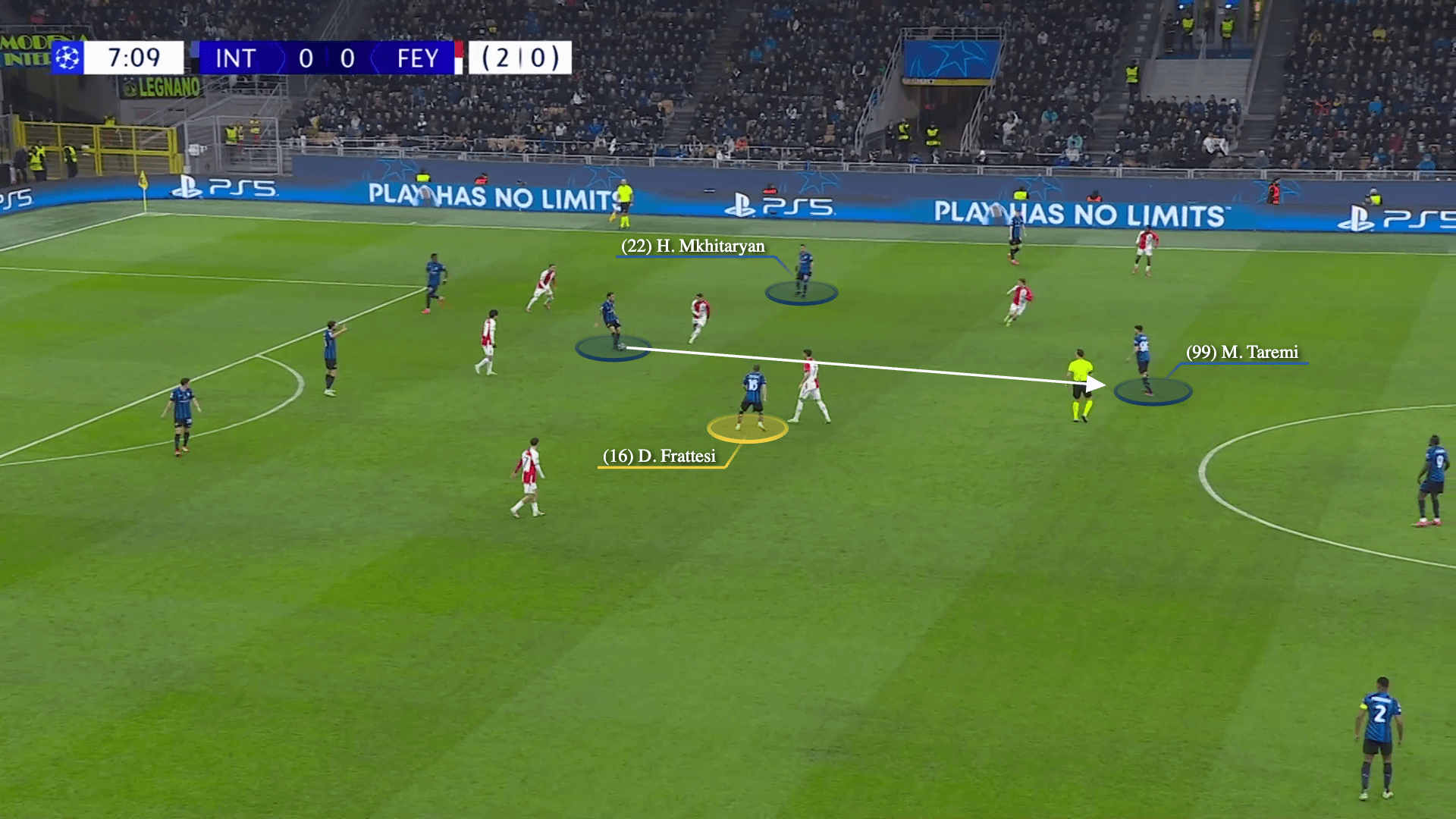
When Inter conceded an equaliser in the 85th minute of their quarter-final encounter against Bayern Munich, they didn’t accept the draw or rush to attack their opponents.
Instead, Simone Inzaghi’s side played out the remainder of the game as if it was just beginning, and their coolness on the ball allowed them to build an attack slowly, combining in midfield to cut Bayern open, before Carlos Augusto found Davide Frattesi’s run into the penalty area for him to score the winner.
Advertisement
Inter were fortunate to be ahead in a balanced first half where Bayern missed their chances, but after the break their defence was minutes away from keeping a clean sheet, until Thomas Muller was in the right place at the right time to make it 1-1.
The significance of Frattesi’s late winner goes beyond this tie, because it resembles Inter’s attacking play at its best: daring, methodical and artistic — ‘il calcio futuro’ as some might call it.
Yet, instead of looking into the future it’s important to examine the past.
Frattesi’s goal at the Allianz Arena has become a trademark move under Inzaghi, where Inter combine on one side of the pitch with the help of one of the centre-forwards, while the midfielder on the other side advances to attack the space.
One variation of this move starts with Inter finding their dropping centre-forward…

… who combines with the wide centre-backs or the midfield trio to progress the ball down the flank. Meanwhile, the midfielder on the other side dashes forward to attack the space.
Here, against Feyenoord, Mehdi Taremi drops and Inter combine through him to move the ball towards the left side. Taremi’s positioning forces Feyenoord’s right centre-back to move up and Marcus Thuram attacks the vacant space, which helps Inter’s right midfielder, Frattesi, who is dashing forward as the ball is being moved towards the left side.
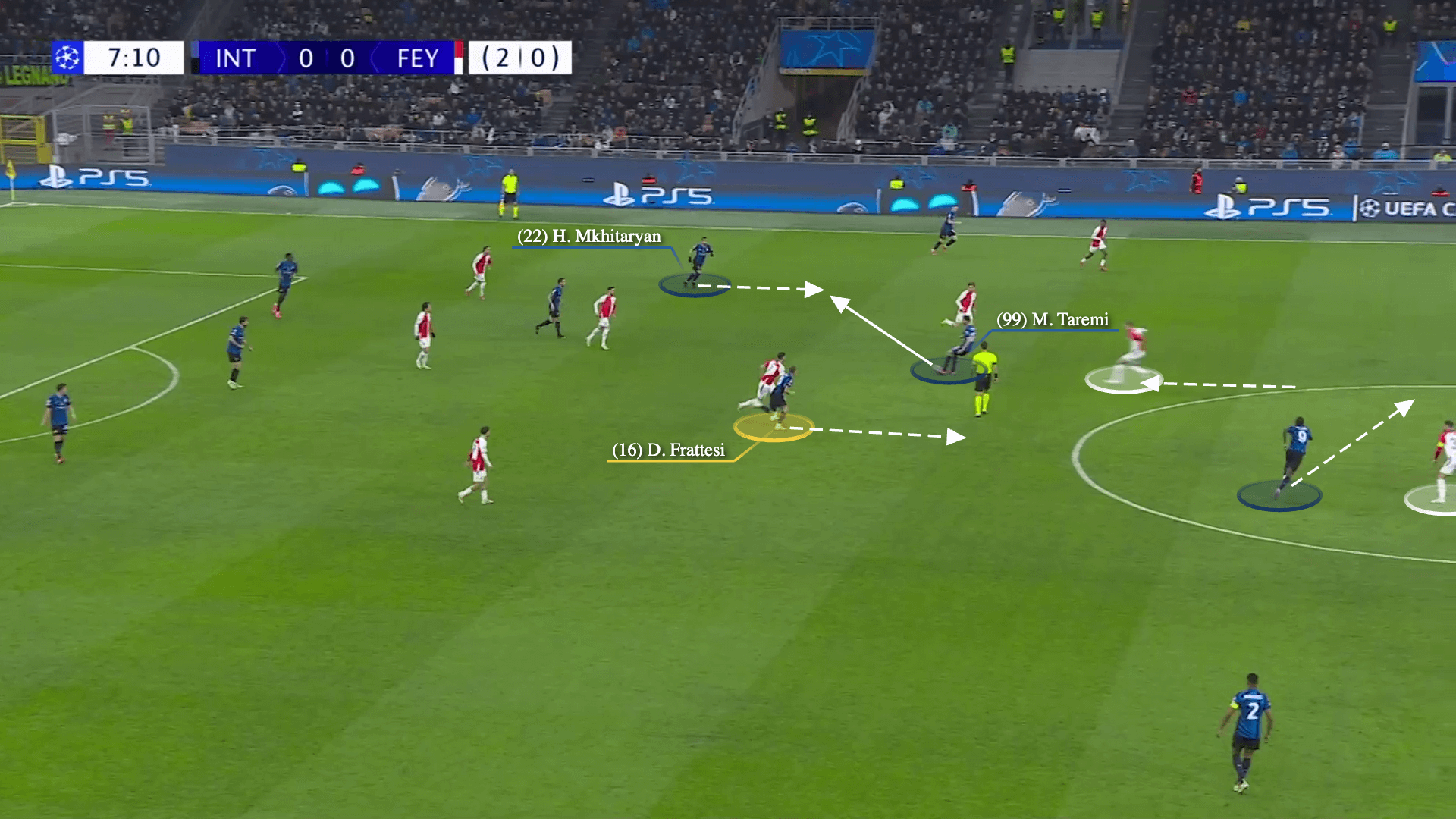
Thuram’s movement drags Feyenoord’s left centre-back out of position and creates space for Frattesi to attack, with the opposition left-back distant due to Denzel Dumfries’ threat down the wing.
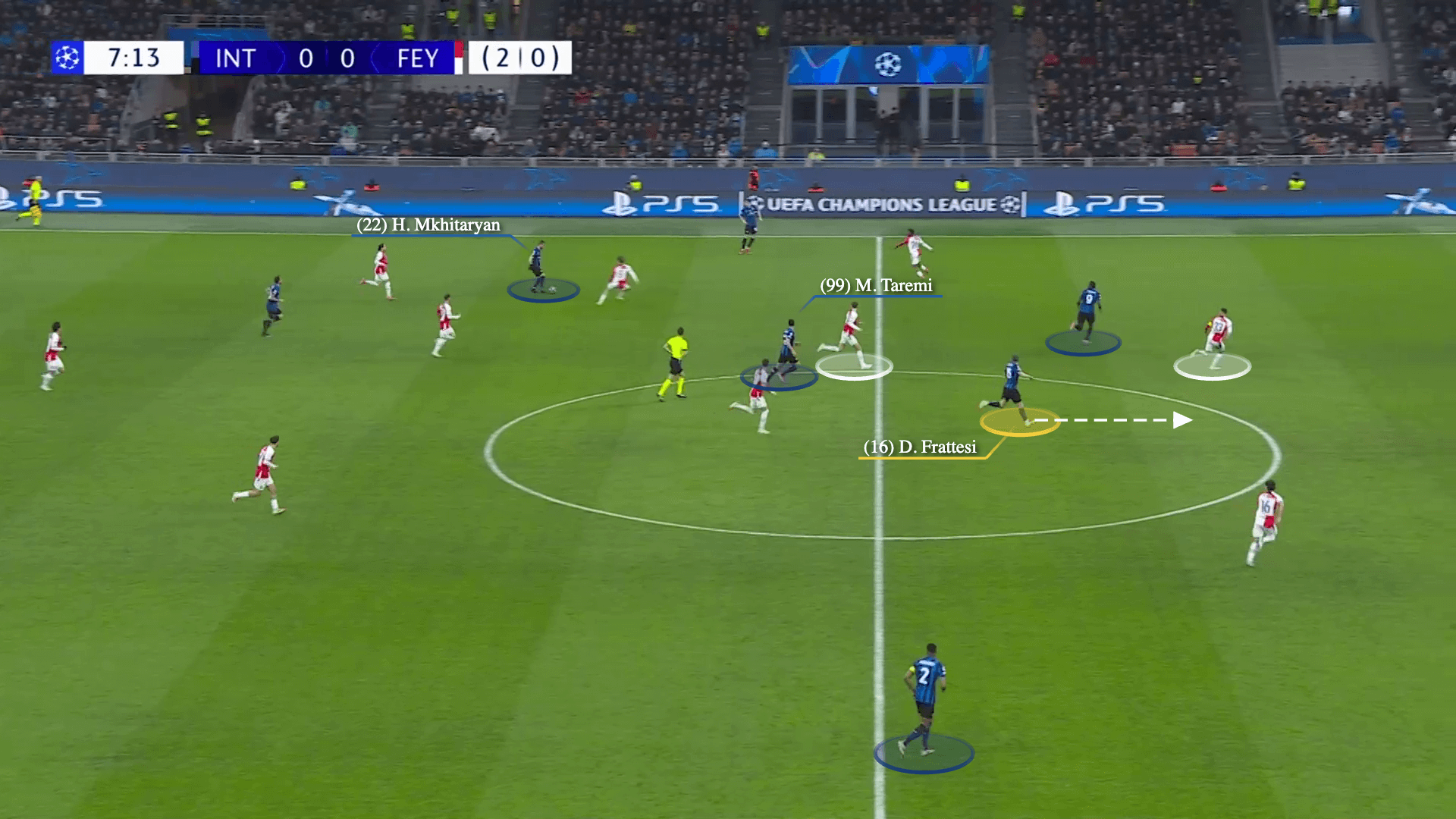
In this next example, against Parma in December, Inter are attacking down their left side and Federico Dimarco chips the ball…
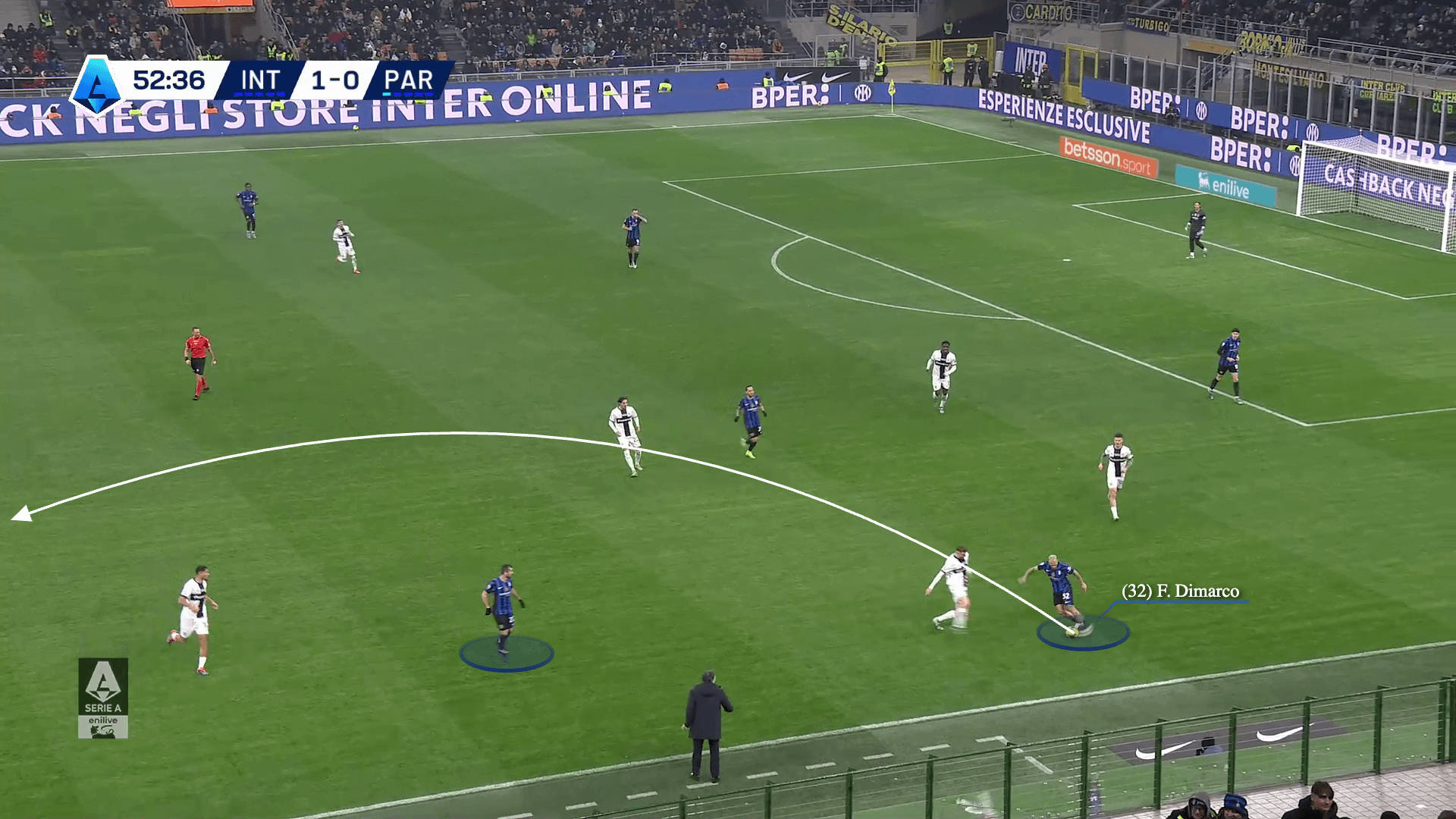
… towards a dropping Thuram, who chests it back to Henrikh Mkhitaryan. Meanwhile, Inter’s right-sided midfielder, Nicolo Barella, dashes forward to attack the space between Parma’s left-back and centre-back.
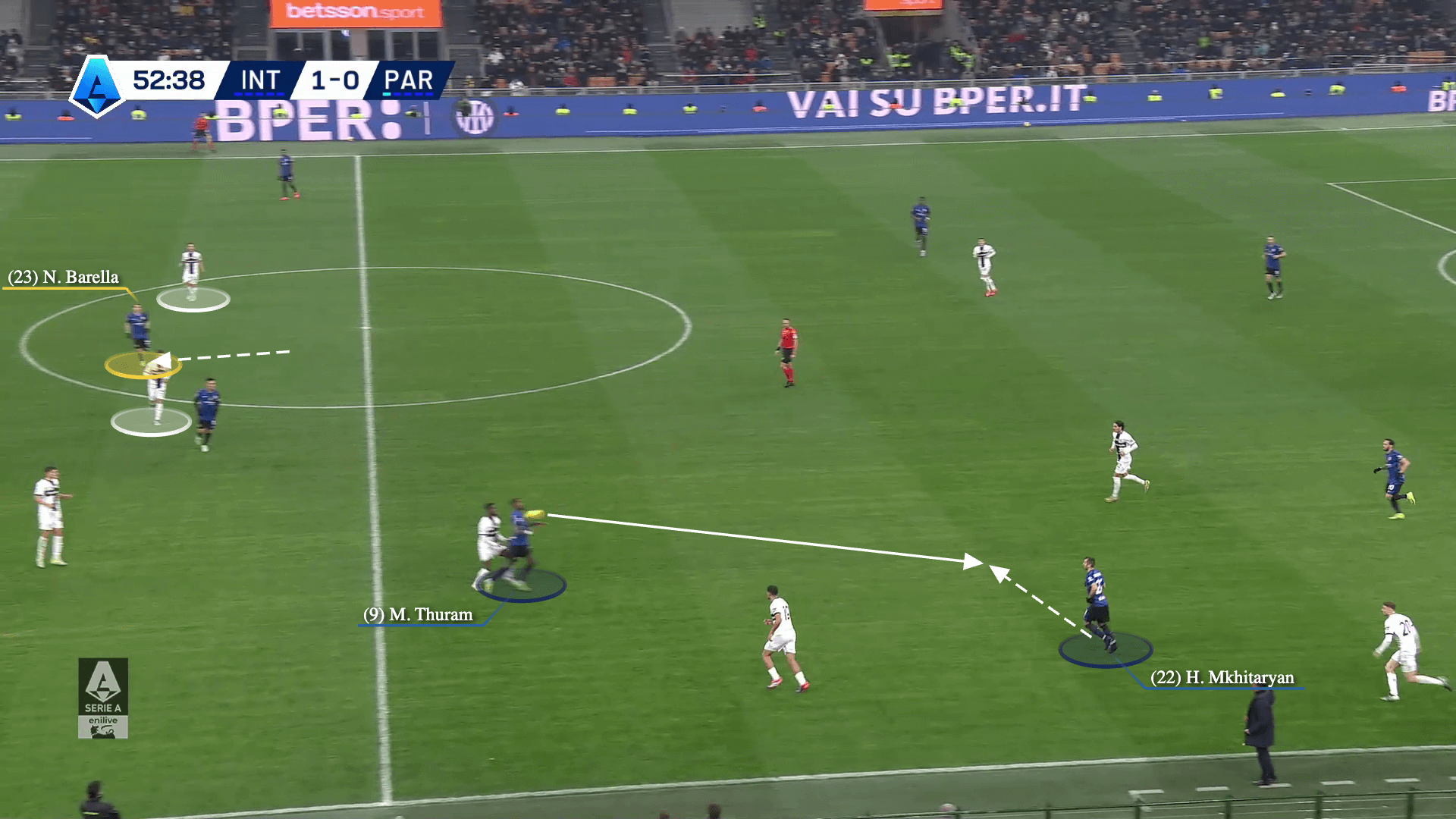
As the ball is moving towards Mkhitaryan, Lautaro Martinez drops to drag Parma’s centre-back up the pitch and create space for Barella to attack. Again, it’s important to note Dumfries’ advanced position, which forces the opponent’s left-back to be in the middle between him and Barella and not close enough to the Italy midfielder.
Mkhitaryan then finds Barella’s run behind the defence with an exquisite half-volley…
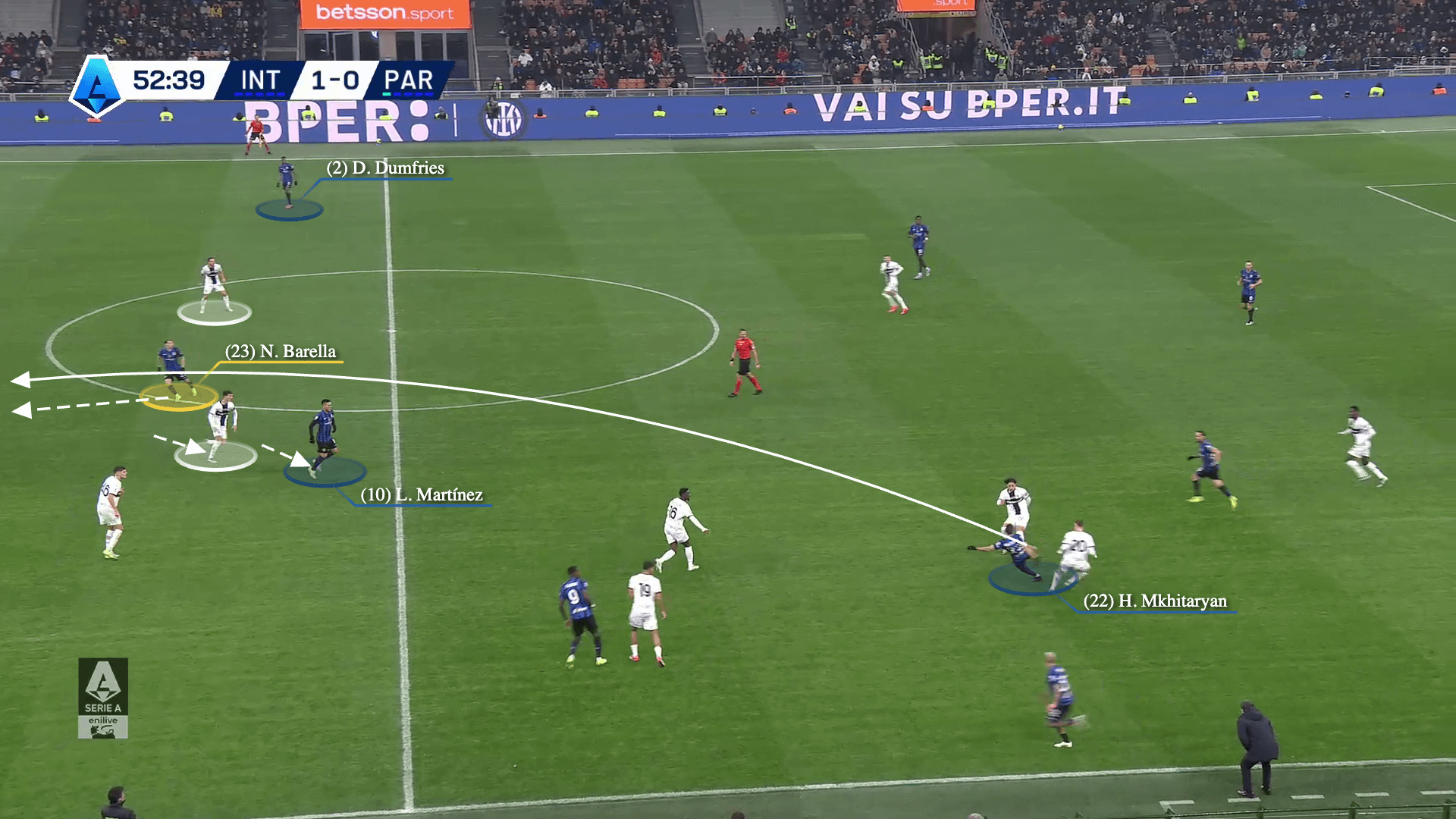
… and the latter scores after dribbling past the recovering left-back.
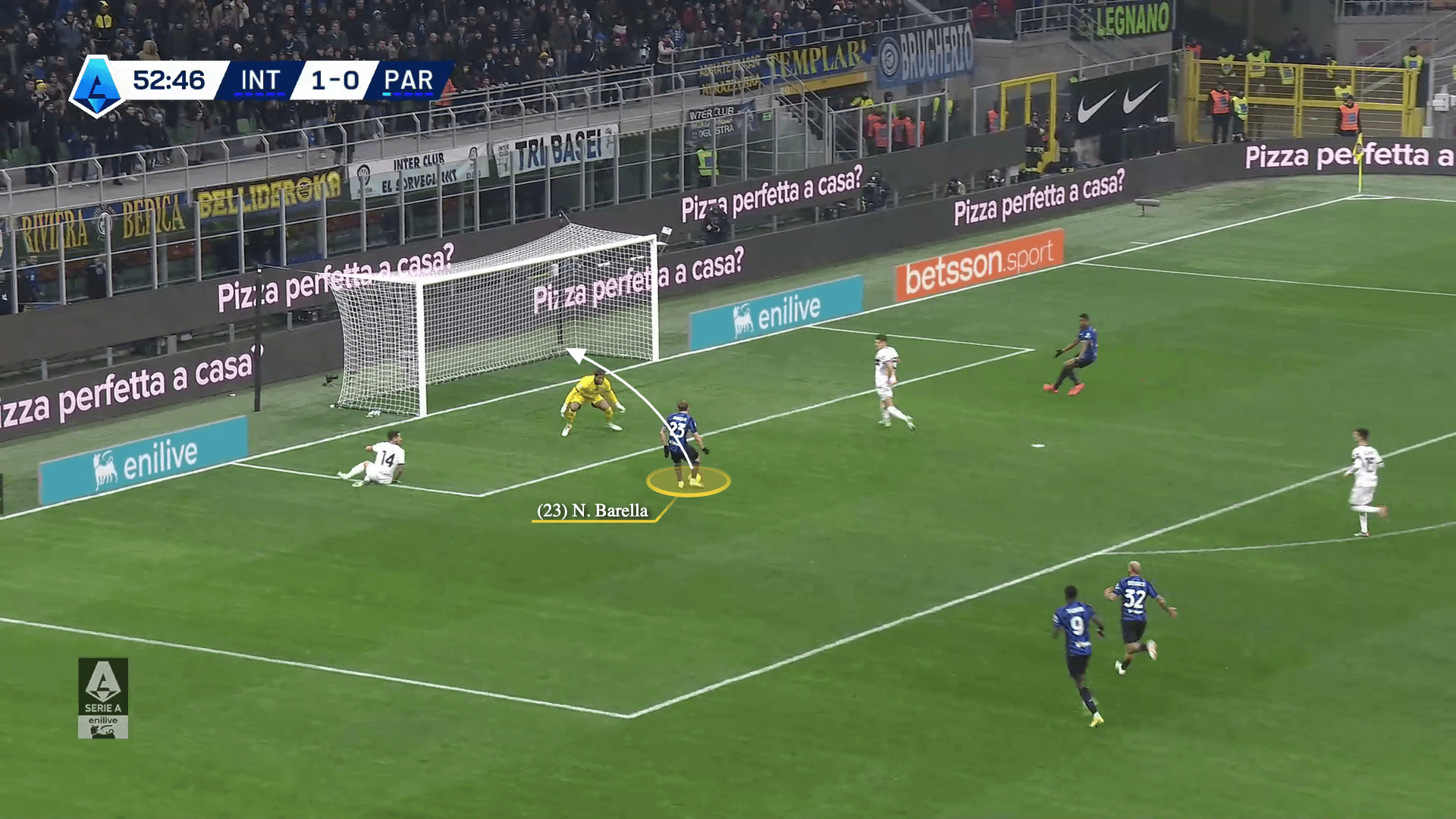
Inter don’t always use one of their centre-forwards in their passing combinations.
In this example, against Udinese last month, Augusto directly finds Mkhitaryan down the left side. Initially, Inter’s right midfielder, Frattesi, is marked by Arthur Atta…
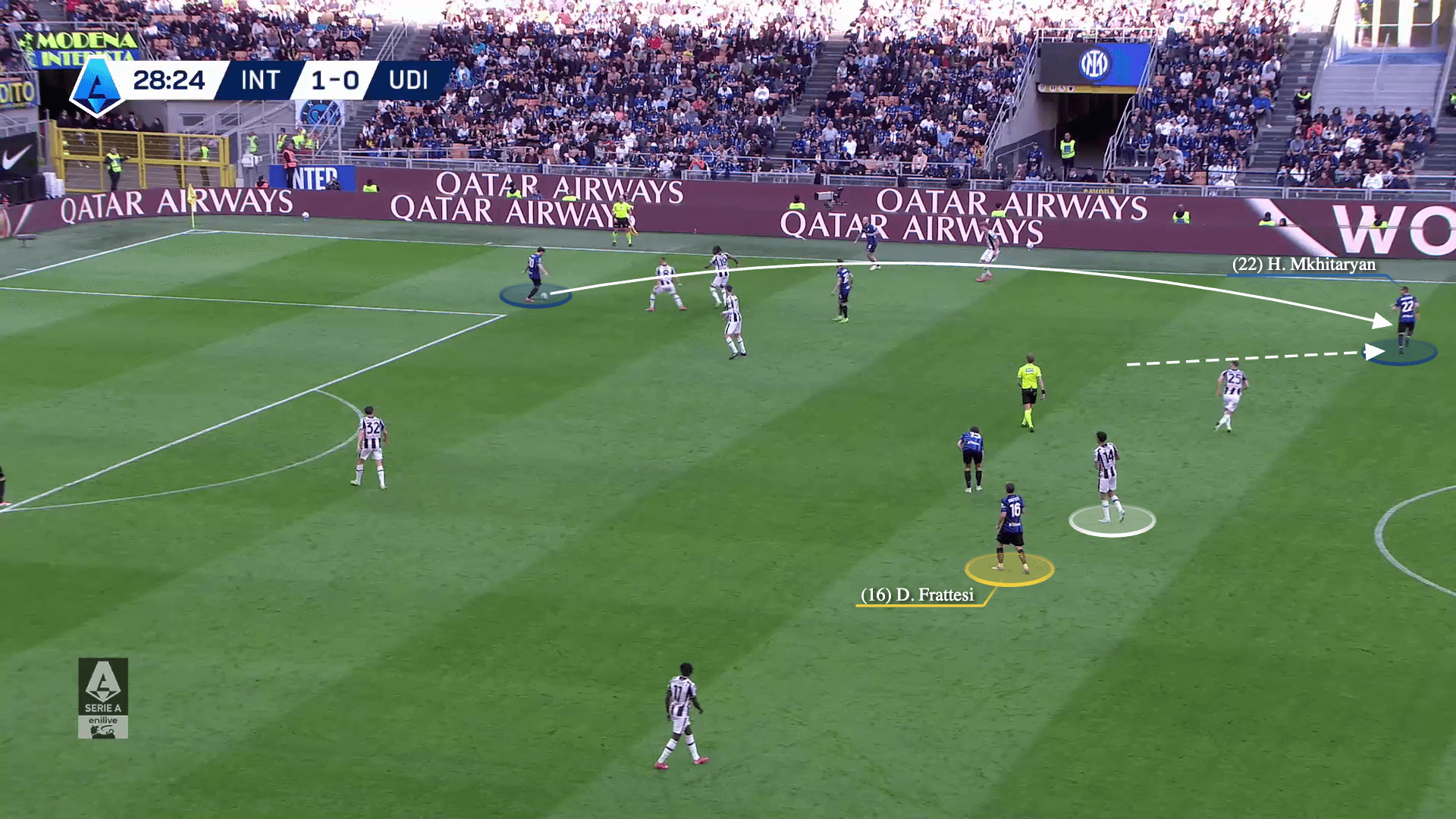
… but the Udinese midfielder is dragged towards the ball to help the right side of the defence. This mistake proves to be costly because, as Mkhitaryan carries the ball forward, Frattesi is surging up the pitch to be in position to attack the space.
When Mkhitaryan finds Dimarco’s overlapping run…
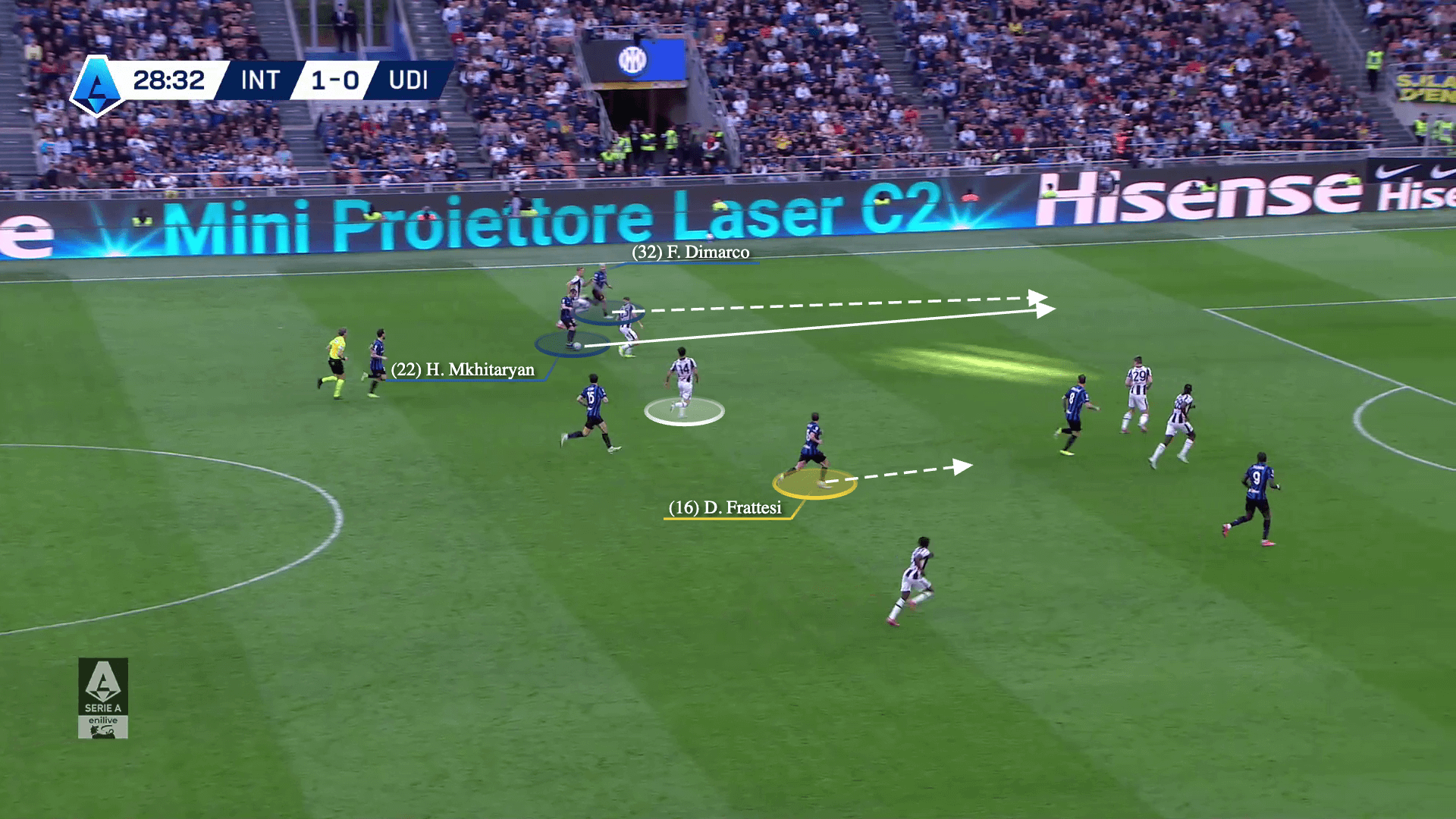
… Frattesi is ready to attack the space between Udinese’s midfield and centre-backs who are forced deeper by Thuram and Marko Arnautovic’s movement.
Dimarco chooses the correct option and finds Frattesi…
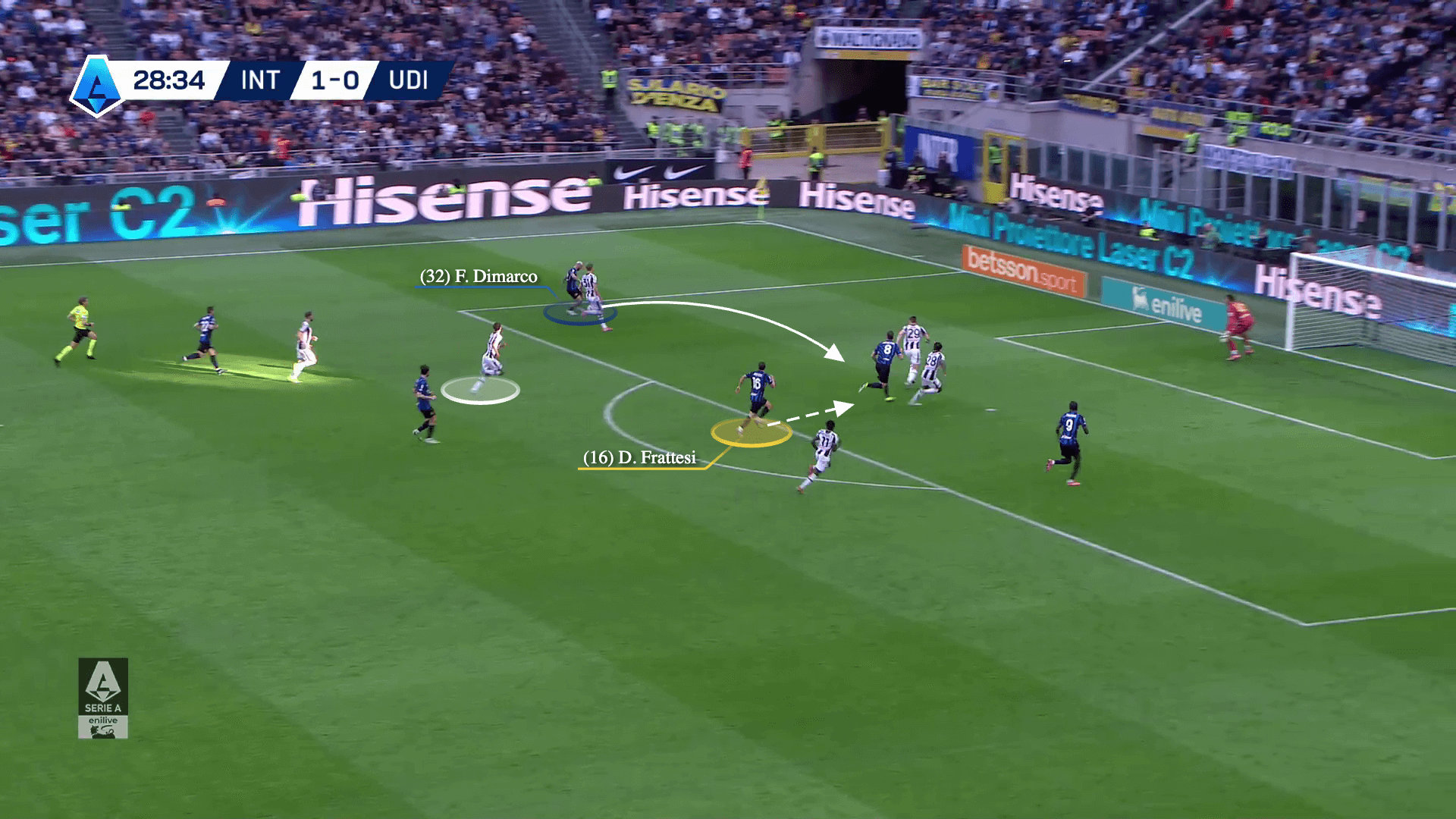
… who puts the ball into the back of the net to complete the move.
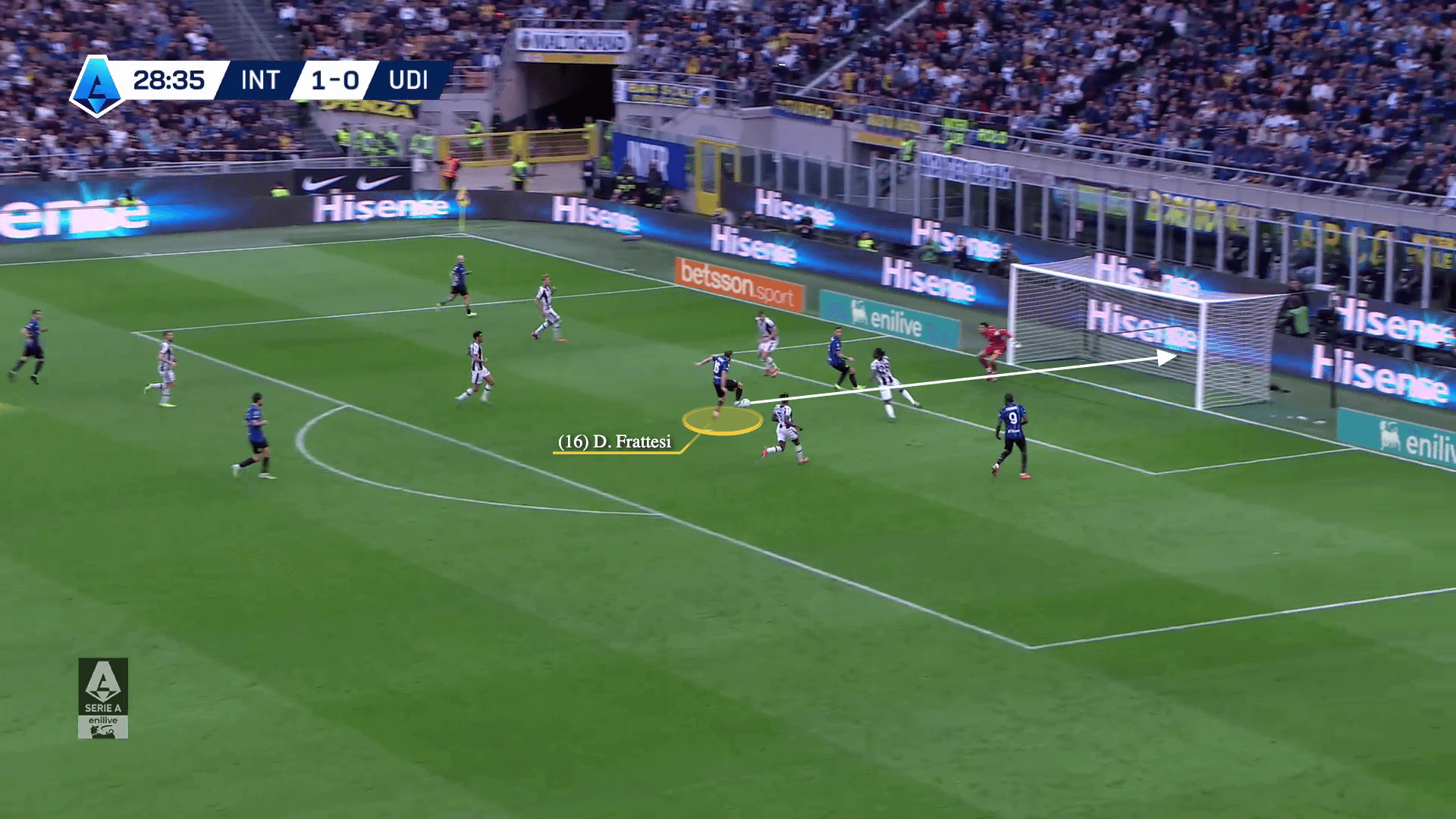
In another example, against Parma last Saturday, Inter build their attack through the right side and find Hakan Calhanoglu, who is playing as the right midfielder instead of Barella.
As Calhanoglu drops to receive the ball from Matteo Darmian…
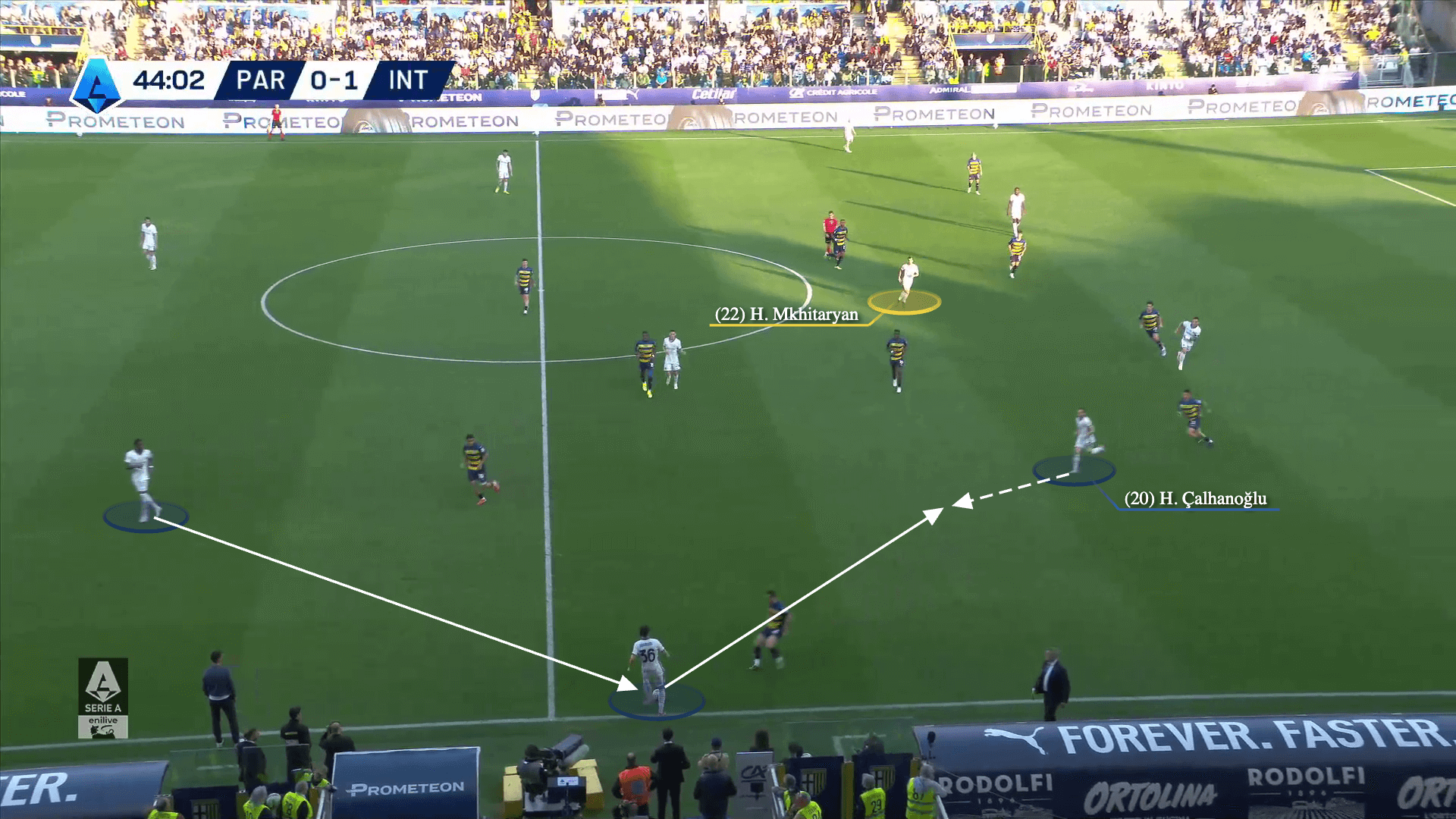
… Mkhitaryan dashes forward to attack the space behind the defence. Parma’s centre-backs try to play the offside trap, but the situational right wing-back, Pontus Almqvist, isn’t in sync with his defence because he is playing out of position and wary of Dimarco and Thuram’s threat.
Calhanoglu then returns the ball to Darmian…
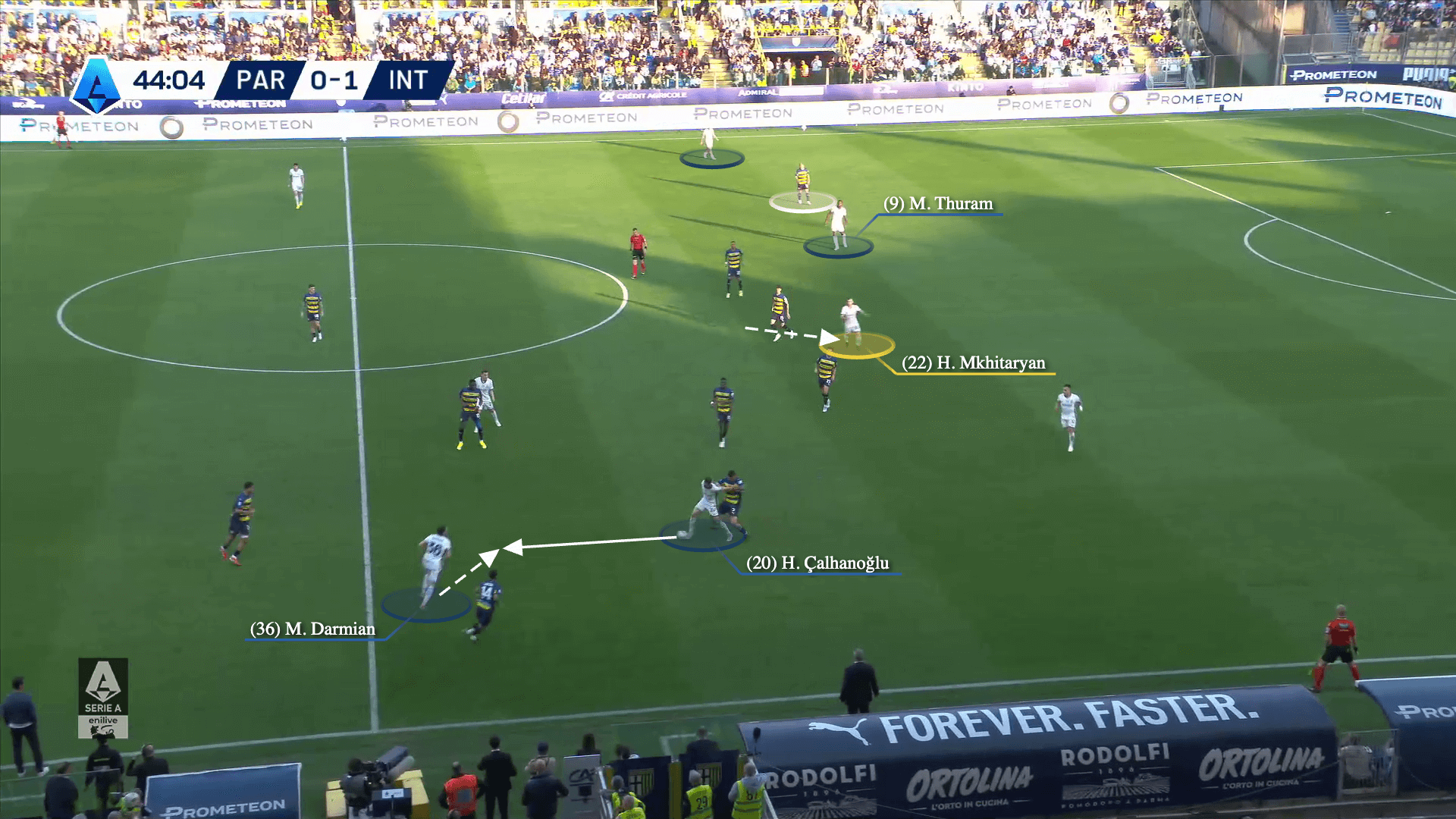
… who finds Mkhitaryan’s run…
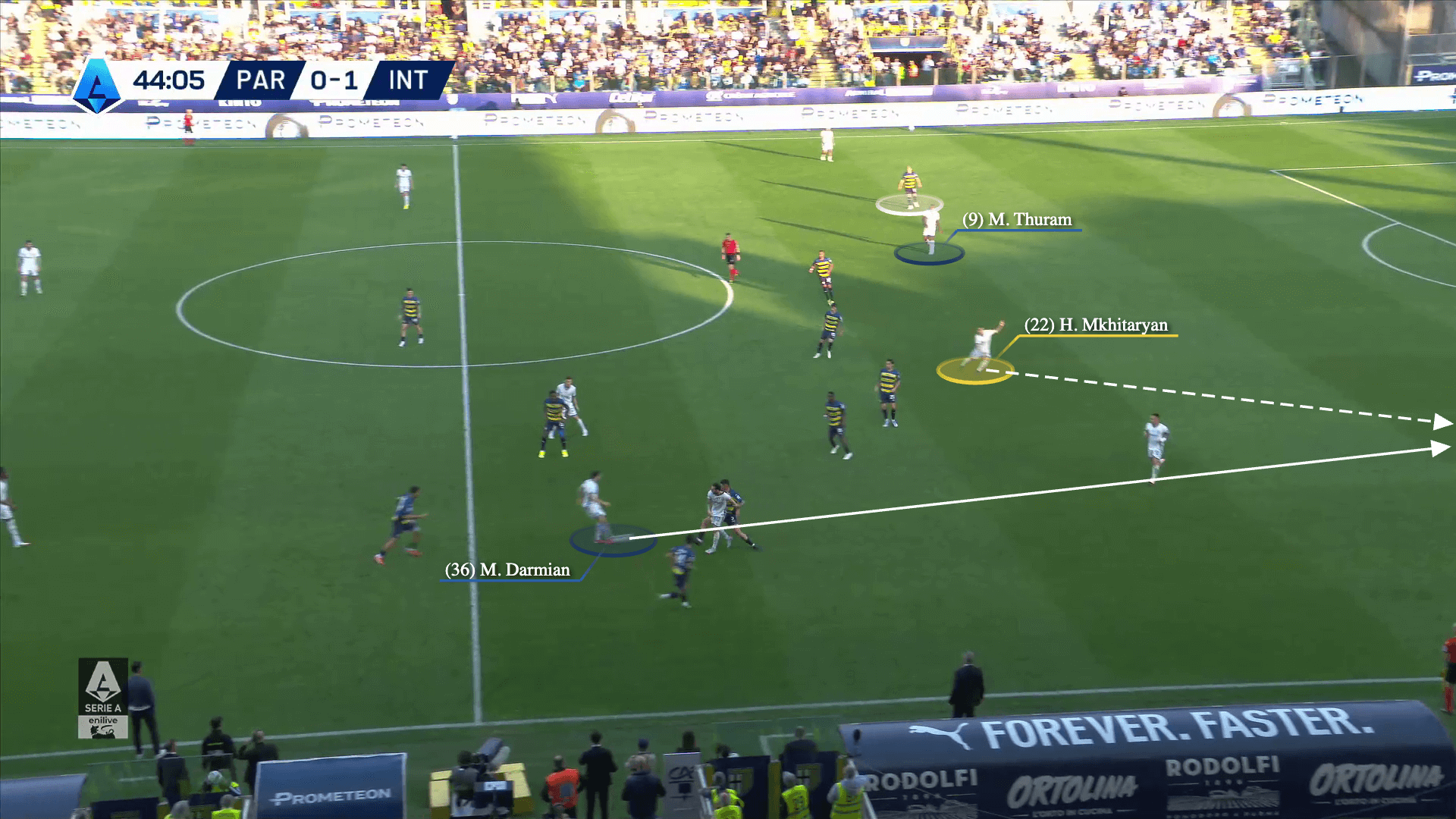
… before the Armenia midfielder sets up Thuram, whose scuffed shot loops over the goalkeeper and into the net.
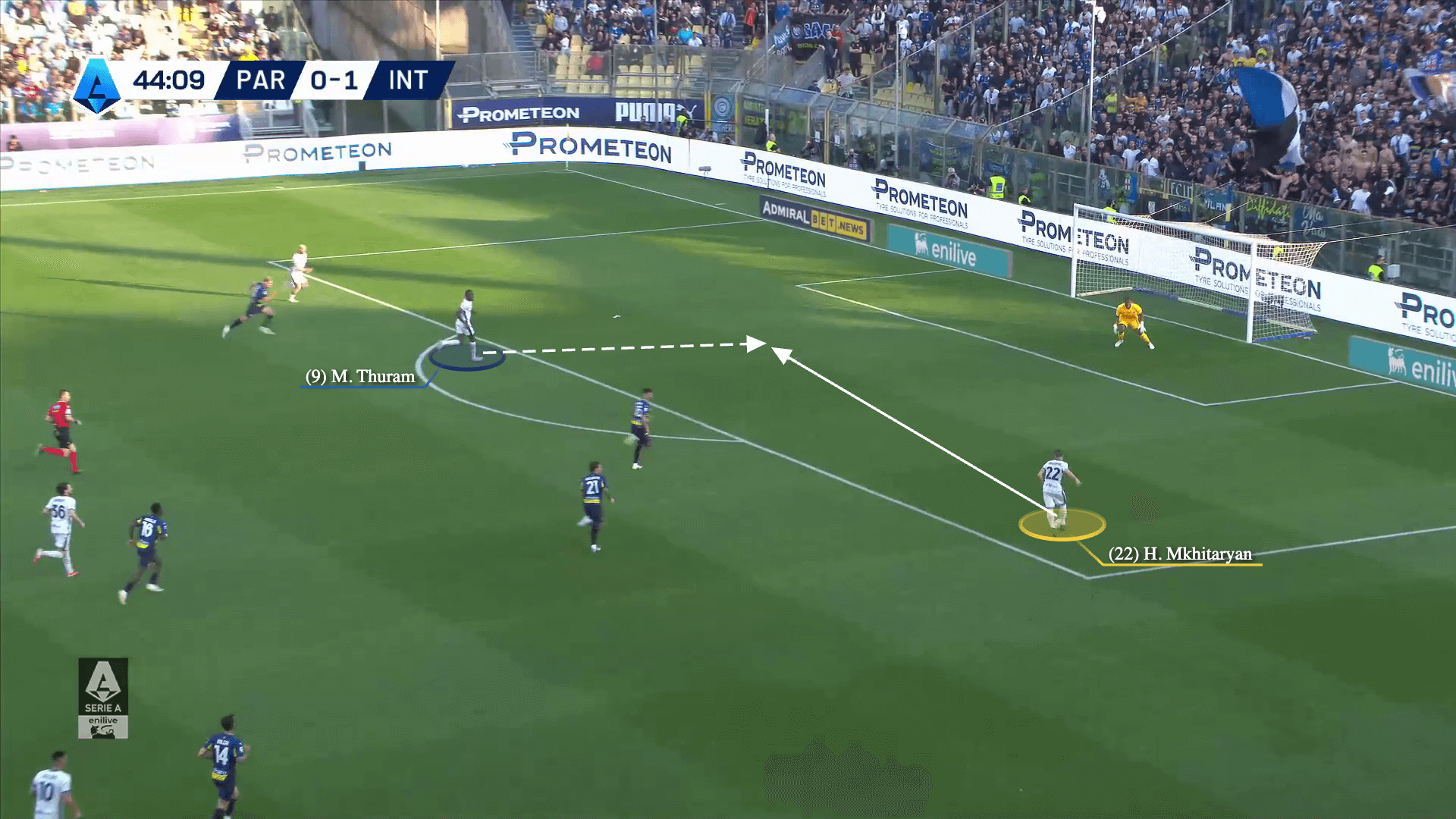
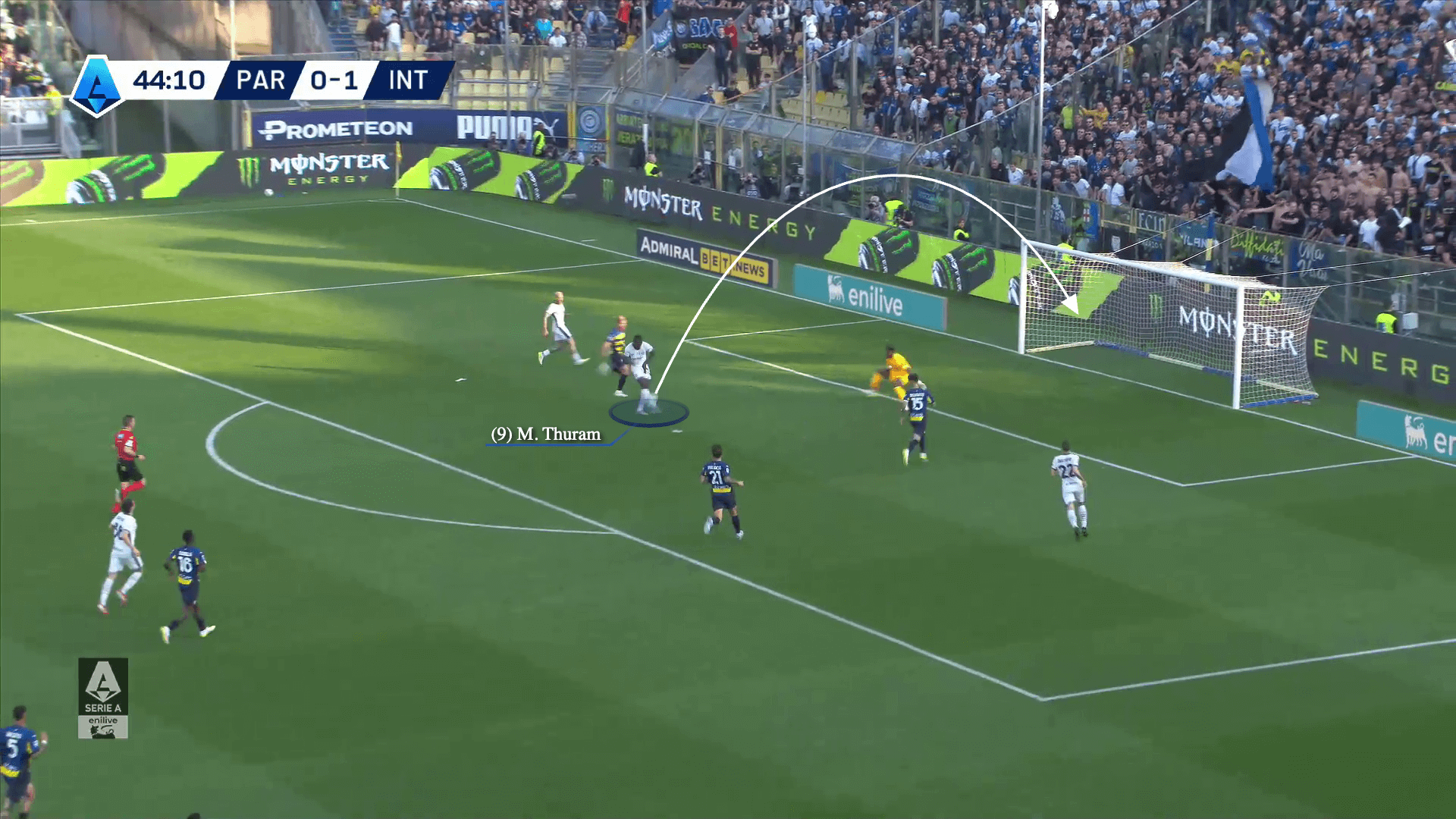
So Frattesi’s goal against Bayern was the same move Inter have been doing all season long.
Here, he is marked by Joshua Kimmich as Barella finds Martinez in the centre-circle. The centre-forward’s positioning forces Josip Stanisic to move up…
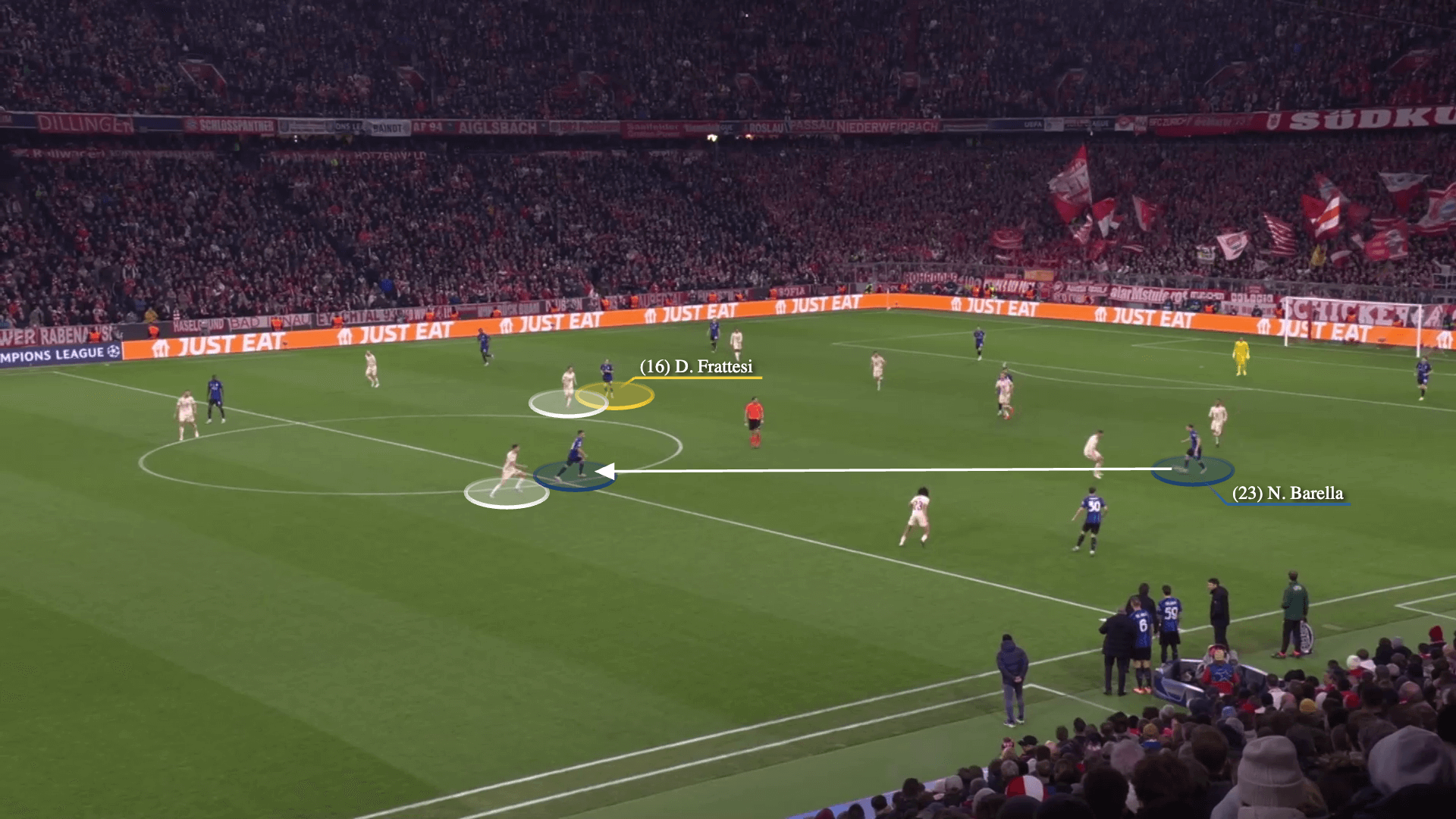
… and vacate space in Bayern’s defence. As the ball is reaching Martinez, Frattesi dashes forward to attack the space and bypasses Kimmich because he knows the pattern, unlike the Germany midfielder who is merely reacting to the situation.
Martinez then returns the pass to Barella with Augusto attacking the wide area to provide another passing option. Inter’s left wing-back can freely attack the space without worrying about being offside because Thuram’s positioning is forcing Eric Dier deeper.
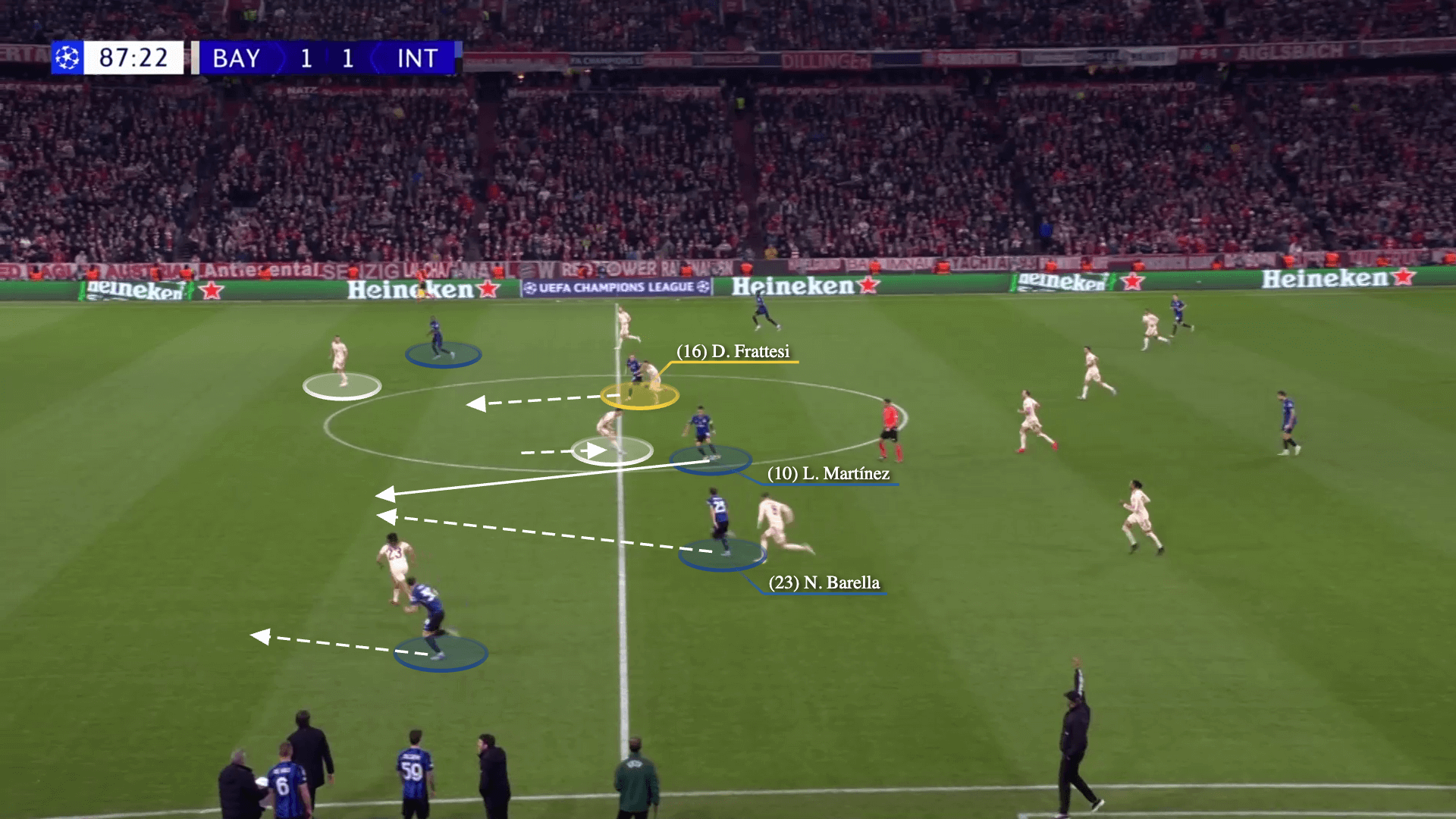
In addition, Thuram’s position on the outside of Dier vacates further space for Frattesi to attack.
Barella then finds Augusto’s run behind Sacha Boey…
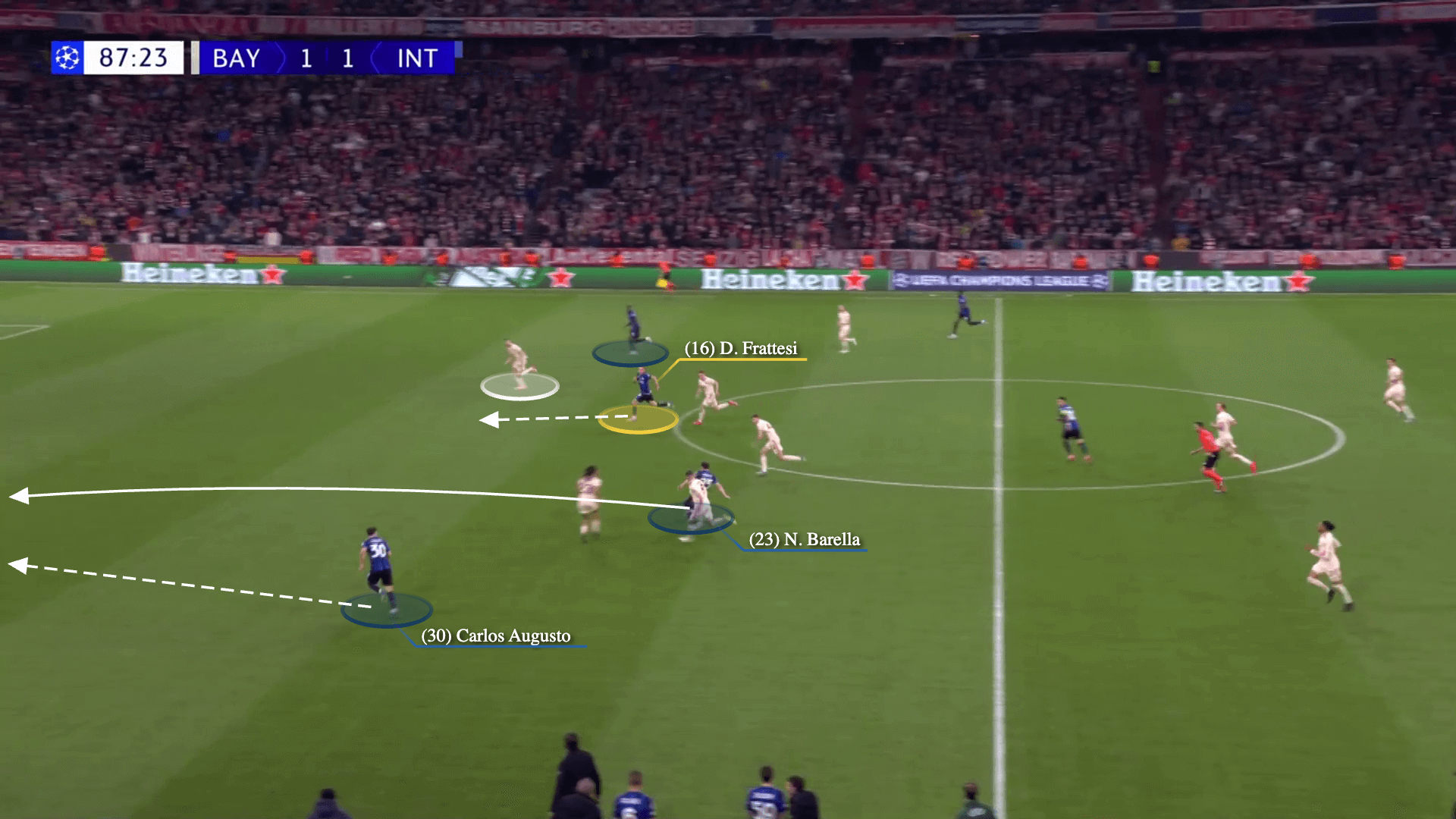
… and the left wing-back squares the ball to Frattesi, who is in the perfect position to score the winner.
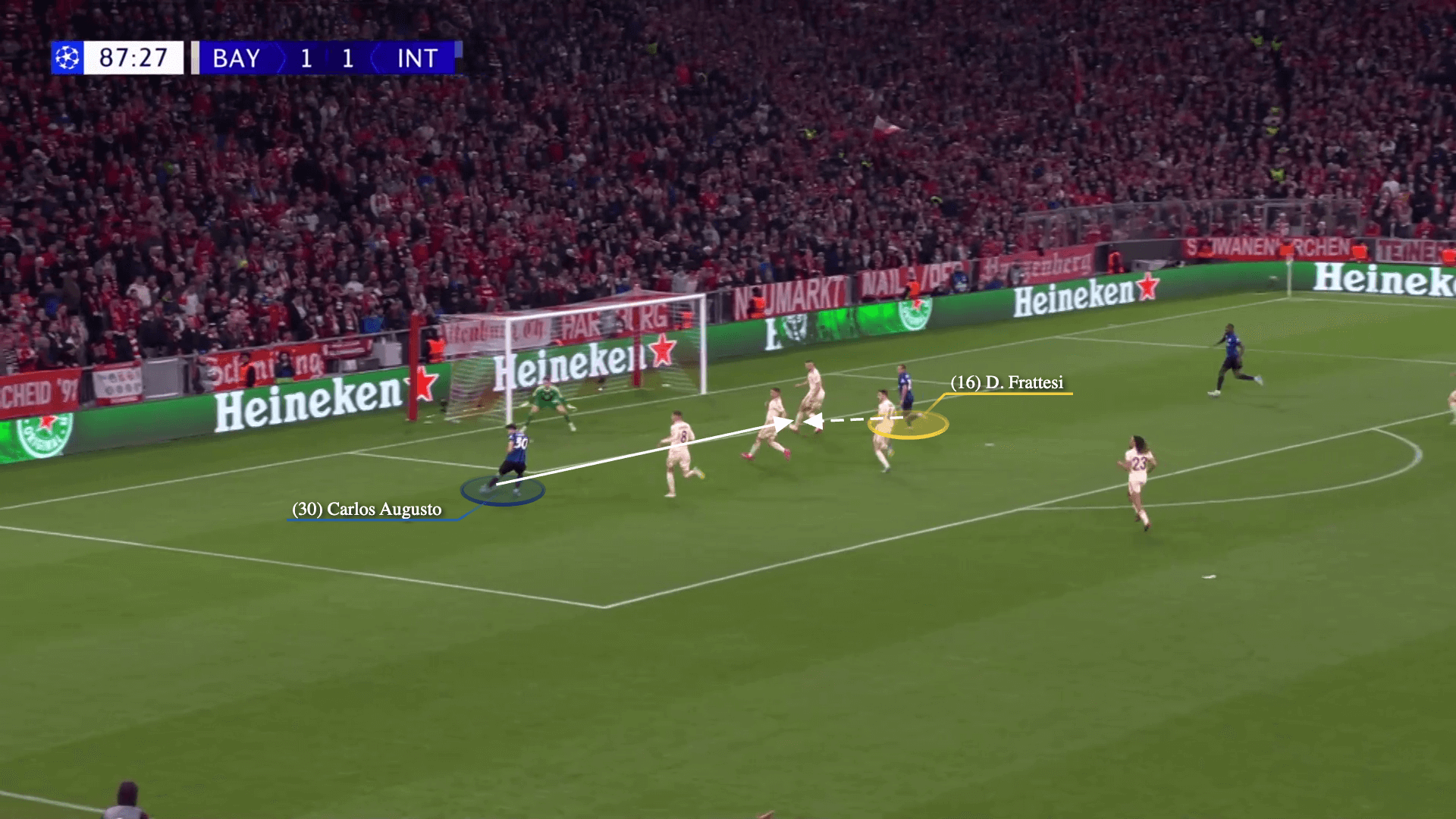
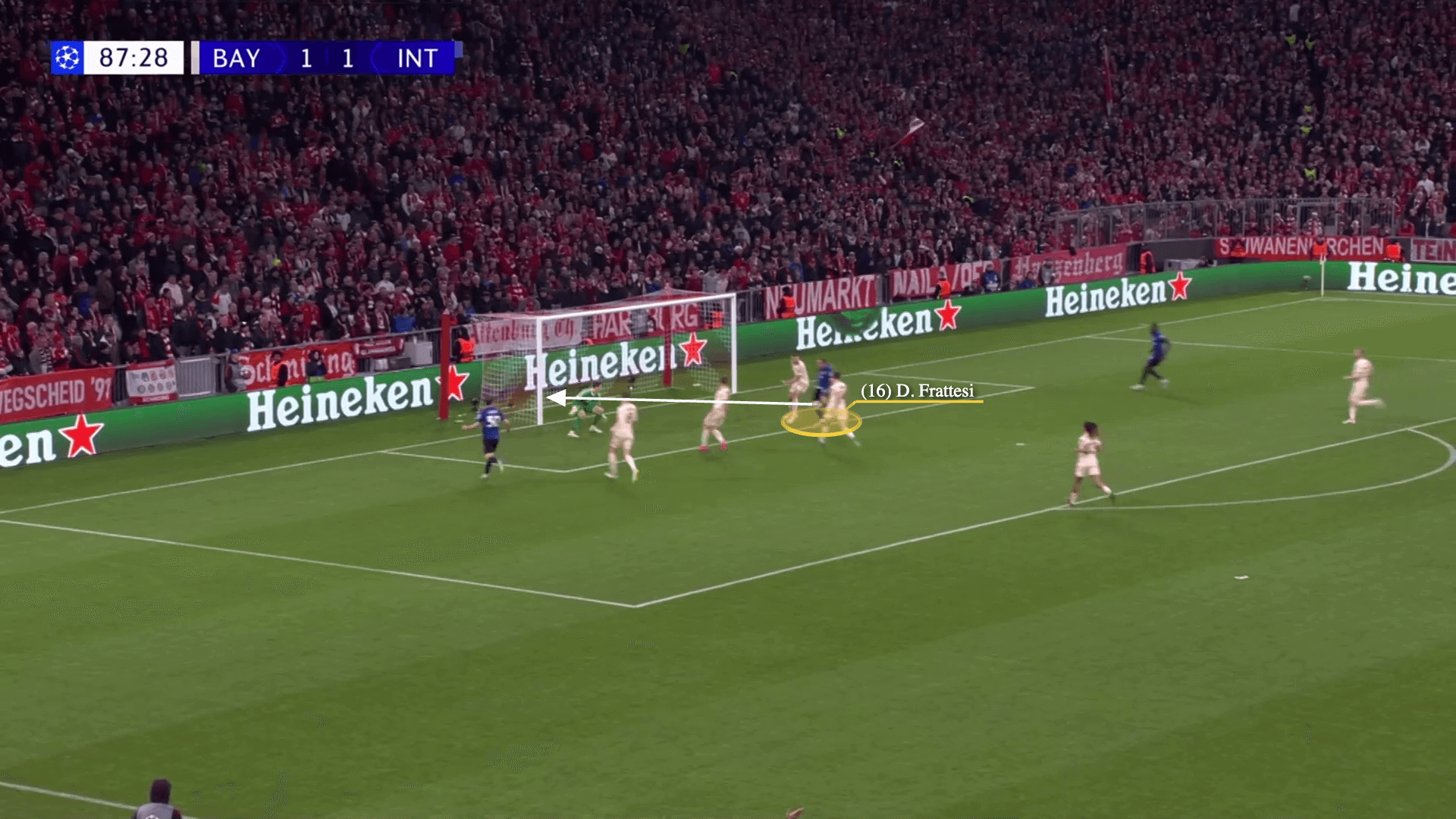
“The goal scored like that shows how the team was (still) in the game and wanted to play until the end with our weapons with our principles that we have known for almost four years,” Inzaghi told Sky Sport Italia after the game.
It’s a goal that encapsulates Inter’s attack and one that they will be hoping to reproduce in the return fixture at San Siro next week.
This news was originally published on this post .








Be the first to leave a comment